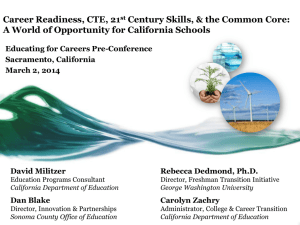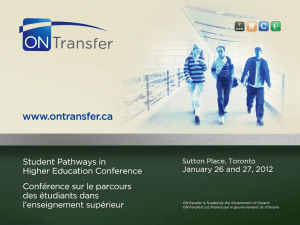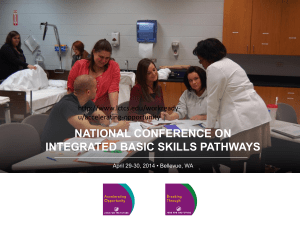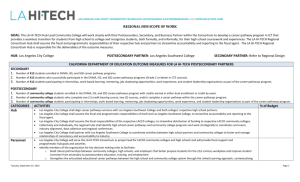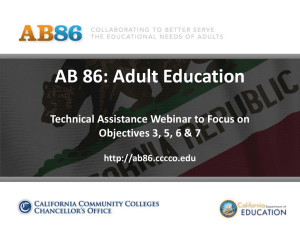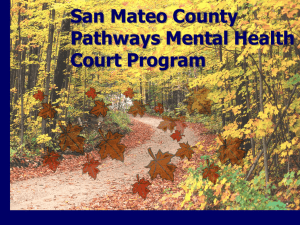What are They Doing in California? - National Association of State
advertisement
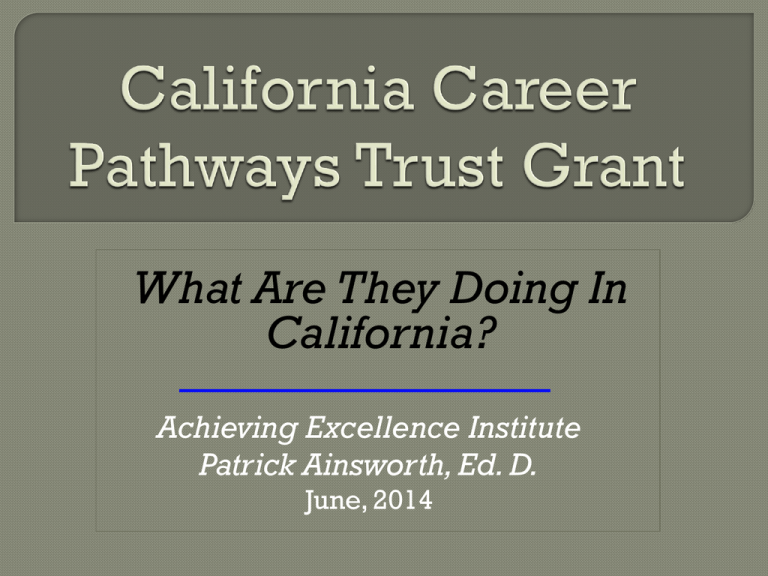
What Are They Doing In California? Achieving Excellence Institute Patrick Ainsworth, Ed. D. June, 2014 Introduce the philosophy and components to the CCPT grant Highlight successful applicants Consider the implications and opportunities available in other states Funds Available = $249,750,000 One-time funding, 2014-15 to 2017-18 2014-15 Proposed Funding = $300 million for new applications Administered by the California Department of Education Overarching goal …build robust partnerships between employers, schools, and community colleges in order to better prepare students for the 21st century workplace and improve student transition into postsecondary education, training, and employment. 1. Establish or strengthen existing regional collaborative relationships and partnerships between business entities, community organizations, and educational agencies. 2. Develop and integrate standards-based academics with a career-relevant, sequenced curriculum following industrythemed pathways that are aligned to highskill, high-wage, high-growth jobs, or emerging regional economic sectors. 3. Provide articulated pathways to postsecondary education aligned with regional economies. 4. Leverage and build on any of the following: Existing structures, requirements, and resources of the Carl D. Perkins Act, California Partnership Academies, Regional Occupational Centers and Programs (ROCPs), community relationships, and course development. Matching resources and in-kind contributions from public, private, and philanthropic sources. The California Community Colleges Economic and Workforce Development Program and its sector strategies and deputy sector navigators. Participation in the local California Community Colleges Skills Panel. 5. Pathways Must “target” K-14 career pathways Career pathways may be delivered by high schools, ROCPs, California Partnership Academies or other career academies, alternative education programs, continuation schools, county offices of education programs, adult education programs, or community colleges. 1. Participating students will be more prepared for college and career 2. Collaborative regional or county-wide networks are more likely to build innovative and quality (high-skill, highwage, and high-growth) career pathways programs that lead to employment or postsecondary education than programs designed by a single institution. 3. Work-based educational and training opportunities will enhance the employment prospects of low and moderate income individuals, and contribute to the stability and economic development of their communities. 4. Integrated academic and technical learning will best prepare students for both postsecondary education and careers in high-skill, high-wage, and high-growth sectors of the economy. Regional Consortium Grants: 10 grants planned; 12 awarded up to $15 million Regional or Local Consortium Grants: 15 grants planned; 16 awarded up to $6 mil. Local Consortium Grants: 15 grants planned; 11 awarded up to $600,000 CDE could award a reduced amount for individual grants or award fewer or more grants per category 2014 –15 50 % of the total award 2015 –16 35 % of the total award 2016 –17 15 % of the total award 2017 –18 Additional funding lifespan 1-21-14 RFA Release Date 2-14-14 Letter of Intent 3-28-14 Online application deadline April May Application scoring process 5-30-14 Grantees Announced 6-6-14 Appeals received at the CDE 7-1-14 Project Term Begins Regional/Local consortium of multiple local K-12 LEAs, community colleges, and business partners Formed to address the employment needs of a specific economic region Must submit a Partnership Agreement Letter of Intent submitted by February 14, 2014 Must identify an applicant agency/fiscal agent to prepare application, coordinate the grant implementation, and prepare reports Partners must coordinate and funding to operate and sustain the program commitments Member agencies can participate in other applications Focus on high-skill, high-wage, highgrowth jobs, in industry sectors that drive the regional economy Required to provide labor market data and projections and define skills gaps Specific Partner Responsibilities – See handout Innovative approaches Funding of an intermediary organization Career specialists to support pathways and work-based learning Curricula and instructional materials Professional development Purchase equipment Planning meetings & service contracts Cannot supplant existing funding or efforts Provide sub grants to members Purchase furniture or facilities Provide food or promotional items Services to non-pathway students Number of students enrolled in the career pathways program. Number of students who have successfully participated in the career pathways program (defined as a “C” grade or better in all pathway courses). Number of students participating in workbased learning: internships, mentoring, job shadowing, work experience, and student leadership organizations. Number of students in the career pathways program who received a high school diploma. Number of students in the career pathways program who received a nationally recognized or state approved career technical education (CTE) certificate. Number of students enrolled in the career pathways and credits earned in either dual enrollment or credit by exam. Number of students who completed one credit-bearing course, two courses, and/or completed a career pathway. Number of students in work-based learning Number of students who transitioned from community college to a California State University, University of California, or private university. Number of students who received an Associate of Arts degree or Associate of Science degree. Number of students who entered employment or training. Number of students who received a nationally recognized or state approved CTE certificate. What surprised or impressed you about the background of the grant presented so far? Who would you see leading a state or regional effort like this in your state? What questions do you have so far? Agreement on fiscal agent Commitment of partners Partner agreements Determine who are the lead staff members responsible for assisting with the application Decide on the program components and services to be funded by the grant and from other sources. Describe: Work-based learning Student leadership skills Integrated academic and career based courses Career exploration and planning Support services Transition services Describe: Industry sector skills analysis Soft skills contextualized in CTE Dual enrollment and/or early admission into aligned postsecondary career programs. Industry partnerships Describe: Projected numbers of students served Programs of study, grades 9-16 Roles and responsibilities of partners Matching funds Data collection processes Plan for sustainability Letters of Intent = 258 representing $1.5 billion in requests Applications Submitted = 123, containing request for $709 million Awards given to 39 Applicants; 12 - up to 15 mil, 16 - up to $6 mil, and 11 - up to $600,000 (See Handout) Los Angeles Unified School District consortium Targeting five high-skill, high-growth industry sectors in Health Science, Medical Technology Culinary, and Environmental Resources. Education agencies include the LAUSD, Centinela Valley High School District and Da Vinci Science High School. Industry partners include Kaiser Permanente, the LA Chamber of Commerce, Gold Star Foods, Southern Calif. Gas Company, Tyson Foods, Time Warner Cable, and the Boeing Company. East San Francisco Bay Consortium, Preparing students for 4 critical sectors : Health Sciences, Engineering (including Advanced Manufacturing), Information and Communication Technologies/Digital Media, and Public Service. Industry partners include Bayer, Oakland Children’s Hospital, Bio-Rad, San Francisco General Hospital, Lawrence Livermore Laboratory, Turner Construction, BAYWORK, Terminal Manufacturing, Autodesk, Maxon Computer, the Alameda County Sheriff’s Office, and the Richmond Police Department. Ventura County Partnership - Ventura County Office of Education, Ventura Community College, 15 school districts, and 50 employers. Expand the number of pathways to 62 serving 35,000 students Two year Air Academy allowing students to build and fly Unmanned Aerial Vehicles - drones. Certification exam leading to pilot license. Paramount Agriculture Career Academy (PACA) Collaborative among the Paramount Academy charter school, four school districts, three community colleges, six major agriculture production and processing companies. PACA will immerse students from five high schools in a demanding, integrated academic program of study with three agriculture-themed pathways: Agricultural Business Management, Agricultural Mechanics, and Plant Science. Executives from each company identified plant science, mechanics, and business as the fields with the greatest current and long-term needs for skilled applicants. The agriculture sector is the region's largest employer base. What innovative programs are occurring in your region or state? How could you get business to fully participate in supporting CTE? What would it take to implement this in your state? What questions can we answer? Information on CCPT available at: http://www.cde.ca.gov/ci/ct/gi/ccptinfo.asp Patrick Ainsworth Consulting and Leadership Services Painsworth @painsconsult.com

